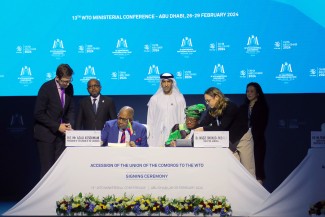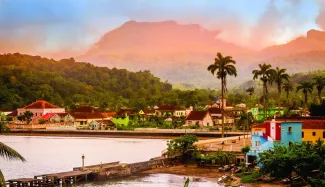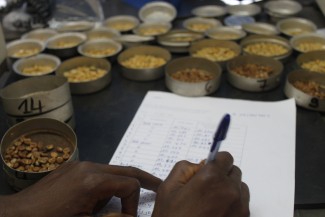With a sharp decline in tourism in 2020, what does the future look like?
Tourism is a vital source of income in least developed countries (LDCs), accounting for 9.5% of GDP and a similar share of employment. The World Trade Organisation (WTO) estimates that travel accounts for 50% of services exports in LDCs, and for individual LDCs, tourism accounts not only for a significant share of total exports (63% in Vanuatu, 26% in Rwanda), but also for a large share of GDP (48% for Vanuatu).
The global tourism and travel sector has been the hardest hit by the COVID-19 crisis so far, largely due to global mobility restrictions and border closures. The World Tourism Organisation (UNWTO) forecasts a potential decline of 58-78% in international tourist arrivals for the year, with 100-120 million direct tourism jobs at risk, and potentially reducing global GDP by 1.5-2.8%.
Challenges and opportunities
LDCs face particular challenges as a result of the crisis, making the freefall in their tourism sectors even more acute. Besides being highly dependent on travel and tourism revenue for economic activity, LDCs face significant levels of economic, financial and social vulnerability, including to external shocks like economic disruptions, climactic events and natural disasters.
In many LDCs, the pandemic has severely impacted the informal sector throughout the tourism value chain, notably vulnerable, marginalised groups, with tourism workers potentially displaced into seasonal agricultural work. For example, in Vanuatu, with women comprising over half of the informal sector primarily in food services and traditional handicrafts, the pandemic has inhibited sourcing from local community producers, tour operators and village businesses, severely impacting incomes and livelihoods.
The halt in tourism has had further potential catastrophic consequences for eco-tourism and wildlife resources, particularly in African LDCs, as environmental crimes have compromised conservation and biodiversity efforts, with knock-on effects for vulnerable communities reliant on this income. The pandemic has crippled the air transport supply chain servicing smaller, remote LDC economies due to non-viability of air travel amidst shrinking passenger numbers. Further, longer-lasting repercussions for LDC tourism risk being perpetuated unduly, due to potential disproportionate, enduring trade restrictive and arbitrary regulatory measures.
At the same time, the COVID-19 crisis presents opportunities for LDCs to differentiate their tourism offerings, as quarantine-weary travellers will increasingly seek appropriately ‘social-distanced’ holidays in natural, open, non-urbanised environments, as opposed to dense, populated cities.
The pandemic is creating opportunities to integrate conservation, ecology, creative industries and cultural heritage offerings. Whether it is chimpanzee rehabilitation in The Gambia, Liwonde National Park in Malawi, gorillas in Rwanda, or Mt. Yasur volcano in Vanuatu, LDC tourism offers abundant choice and unique competitive advantages, including vast natural virus containment zones, whether in self-contained luxury camps in abundant wildlife areas or in archipelagic island configurations.
Best practice in recent recovery strategies
Some countries have been implementing response and recovery plans for the tourism sector based on industry body guidelines, with two broad categories of measures discernible: first, short-term, immediate crisis management responses that include stimulus and relief packages; second are measures that focus on mid-to-long-term recovery. Not only do immediate financial stimulus packages have a finite, insufficient impact, but for many LDCs, unlike more advanced tourism destinations, tourism businesses and workers cannot rely on economy-wide or sector-specific stimulus packages and relief measures.
Accordingly, focussing on post-recovery, sustainable strategies in the mid-to-long term is crucial to ensuring the survival of LDC tourism as a pathway to economic recovery. Though policy responses are highly specific to national contexts, and the duration of disruption to the tourism and travel industry is unknown, some useful lessons can be drawn from country experiences.
On the supply side, some countries have focussed on maintaining existing supply capacity along the tourism value chain, which includes investing in and refurbishing critical infrastructure and capacity and skills development, in preparation for the reopening of tourism markets. Further, enhanced inter-sectoral national and regional collaboration has also enabled building supply-side readiness across regions and with the private sector.
Governments have implemented a variety of strategies to revitalise demand, including nurturing the development of domestic staycations and intra-regional tourism; establishing cross-border travel corridors or ‘bubbles’ between countries exhibiting low infection rates; offering flexible long-stay telework options; and conducting digital marketing and promotion strategies.
Furthermore, the roll-out of comprehensive travel health and safety protocols as markets reopen and border restrictions ease has also garnered tourists’ renewed trust and confidence in tourism destination markets.
Case study in making strides towards resilient recovery
Tanzania started early to proactively build a pathway to sustainable, resilient tourist recovery. The country boasts popular tourist attractions such as Mount Kilimanjaro, the beaches of Zanzibar and Serengeti National Park. Pre-COVID-19, tourism contributed 11.73% to Tanzania’s GDP in 2019 and approximately 11% to employment, supporting nearly 1.6 million direct and indirect jobs economy-wide.
Even though Africa has exceeded one and a half million reported coronavirus cases, at the date of writing, Tanzania had only 509 recorded COVID-19 cases and 21 deaths. Despite relatively low infection and mortality rates, Tanzania has not been immune to the economic hit on its tourism sector, recordinga decline in incoming tourism visitors of 76% relative to 2019, attributable to their major source markets in the US, Europe and Asia being under lockdown.
Nevertheless, recent efforts to revitalise the sector, actively boost sustainable tourism recovery and attract existing and future tourists, including by promoting Tanzania as a safe destination, have started paying dividends, as tourism arrivals have started to rebound, with some national parks reporting increased tourist numbers since June 2020.
In contrast to its neighbours, Tanzania took specific early measures to reopen its skies on 18 May 2020. Resumption of international and regional flights to Tanzania, albeit with testing and screening but no quarantine requirements, has boosted ongoing tourism recovery efforts.
To promote domestic and international tourism, responses involved policy coherence between government ministries as well as proper coordination of implementation efforts between private and public entities in the sector. The Tanzanian Association of Tour Operators and the Ministry of Natural Resources and Tourism, early in the pandemic, proactively identified and mitigated the health risks to appease safety fears, restore confidence and entice tourists back to the country.
The tourism and health ministries jointly established a containment and evacuation system for tourists within national park areas, quickly upgrading health infrastructure, equipped with ambulances and tented medical facilities, and seamlessly integrated with air emergency hospitalisation evacuation services. Additionally, the country implemented industry-wide national standard operating procedures (launched in September 2020), to enable business operators to manage COVID-19.
Relatively early, the country capitalised on the use of virtual, digital media, ensuring that Tanzania remains a preferred choice for prospective tourists. During the lockdown period in Europe, the Tanzanian Tourist Board partnered with wildlife conservation authorities to launch a digital media platform, live-streaming the Great Wildebeest Migration through digital media outlets globally. Besides being integral to recovery, this also ensures ongoing support for conservation efforts to protect biodiversity for the benefit of local communities.
Supporting sustainable, resilient tourism recovery after COVID-19
Tourism export strategies will need to be tailored to a business unusual reality. As the crisis impacts the entire tourism ecosystem, LDC recovery will require a collaborative, integrated approach throughout the entire tourism value chain, whilst prioritising the additional health dimension.
To facilitate trade in tourism, LDCs should actively use WTO mechanisms to ensure that medical, sanitary and food-related merchandise that support the recovery of the tourism sector can move freely across borders; and that domestic regulatory measures and requirements, including those compromising consumption or supply of tourism services, are not applied arbitrarily, discriminately or disproportionately.
Specific interventions under the umbrella of Aid for Trade could include:
- Supporting upgrading of supply side infrastructure, skills and adjustment to health and safety protocols, including for local suppliers, facilitating their integration into tourism value chains and retaining value domestically;
- assisting LDCs to cultivate a whole-of-tourism approach, incorporating initiatives to map and entrench inter-sectoral socio-economic linkages, integrating the informal sector, women, youth and returning migrants;
- assisting a whole-of-government approach to connect ministries and industry players in implementing recovery strategies;
- capacitating LDCs to harvest ‘smart’ tourism data, by tracking trends and demand, facilitating quantification of the tourism contribution of marginalised groups, to enable government design of targeted interventions to recover the tourism sector;
- supporting accelerating digital capacity, digital transformation, utilisation of digital content and virtual platforms, including expanding ecommerce opportunities for local tourism suppliers accessing global customers;
- targeting Aid for Trade interventions to promote and attract sustainable investment in LDC tourism sectors.
-------------
Elements of this paper are based on a prior paper: Kampel, K (2020). COVID-19 and Tourism: Charters a sustainable, resilient recovery for small states. Commonwealth Secretariat. Trade Hot Topics. Issue 163. July 2020.
--------------
Kim Kampel is a Trade Adviser, Trade Negotiations and Emerging Trade Issues with the Commonwealth Secretariat based at the Commonwealth Small States Office in Geneva.
©EIF
If you would like to reuse any material published here, please let us know by sending an email to EIF Communications: eifcommunications@wto.org.



